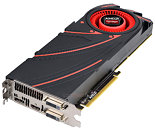Tuesday, October 7th 2014

AMD Cuts Prices of R9 290 Series and R9 280 Series Even Further
AMD cut prices of its Radeon R9 290 series and R9 280 series graphics cards further down from last month's price-cuts. The cuts see the company's flagship single-GPU product, the Radeon R9 290X, drop from $449, down to $399, an $150 overall drop, from its launch price of $549. The Radeon R9 290, on the other hand, has its price cut to $299, from its launch price of $399. The drop in price of the R9 290 is squeezing AMD's sub-$300 lineup like never before. The R9 280X is down to $270, just $30 less than the R9 290. The R9 285, which launched barely two months ago, has its price squeezed to $229, just $10 more than NVIDIA's GTX 760. If you're in the market for a graphics card with about $250 in hand, you're now open to a ton of options, including ramen for a week, in exchange for the $329 GeForce GTX 970.
Source:
Tweaktown

140 Comments on AMD Cuts Prices of R9 290 Series and R9 280 Series Even Further
www.techpowerup.com/forums/threads/205648/unread
You can buy the HIS iPower Radeon R9 290X now for 340 $ after 20 $ rebate card.
www.newegg.com/Product/Product.aspx?Item=N82E16814161457
www.techpowerup.com/reviews/NVIDIA/GeForce_GTX_970_SLI/
Don't care how you cut that, 300 watt's is a lot.
Frame Rate Consistency and Scaling
We experienced something with SLI we aren't use to at 4K gaming. We experienced some inconsistent frames, some low efficiency and poor SLI scaling. We were used to seeing this on AMD GPUs until AMD fixed their issues. AMD implemented a technology called Frame Pacing, and ultimately went the hardware route with XDMA on the AMD Radeon R9 290/X.
At the end of the day, what we find is that GeForce GTX 980 SLI performance is left wanting at 4K, not because Maxwell isn't fast, but because the current implementation of SLI is more inconsistent and less efficient compared to AMD's XDMA technology on the AMD Radeon R9 290X. This is a case of aging SLI actually hindering very capable GPUs. SLI needs an upgrade, it needs to evolve.
We do not think the true potential of the GeForce GTX 980 GPUs are being exploited with current 4K SLI gaming. It is being held back from its full potential. If GTX 980 could be fully and efficiently tapped, two GTX 980 GPUs have the potential to offer a better gameplay experience.
AMD hit NVIDIA hard with this new XDMA technology. Everyone was expecting NVIDIA would strike back with Maxwell by offering its own evolved SLI technology. However, it did not for this generation. That may end up biting NVIDIA in the butt as far as 4K gaming goes in the future.
www.hardocp.com/article/2014/10/27/nvidia_geforce_gtx_980_sli_4k_video_card_review/9#.VFNXfOl0y88
There are places in the US that pay more then that for kwh. Avg is 13 cents as of Augest. Not counting Alaska and Hawaii which are ones that are highest. Some areas are 17-20cents.
www.eia.gov/electricity/monthly/epm_table_grapher.cfm?t=epmt_5_6_a
So any GPU using less power is welcome.
The 290x Shappire Trix OC recently on sale for $325 in my location, way cheaper compare to its introduction price at $615. The gaming performance of this card is on par with gigabyte G1 gtx 970 ( 970 slightly expensive than 290x) but 970 using wayyyy less power consumption. So for me, i will choose any card with less power consumption coz in the long run i will save a lot $$$ on electricity bill.